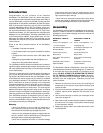
12
4. StarSeeker then asks you to center in the eyepiece the
alignment star you selected. Use the direction arrow but-
tons to slew the telescope to the alignment star and care-
fully center the star in the finderscope. Press ENTER when
centered.
5. Then, center the star in the eyepiece and press ALIGN.
HELPFUL HINT: In order to accurately center the alignment
star in the eyepiece, you may wish to decrease the slew rate
of the motors for fine centering. This is done by pressing the
RATE key (11) on the hand controller then selecting the num-
ber that corresponds to the speed you desire. (9 = fastest , 1
= slowest).
6. StarSeeker will then ask you to select and center a sec-
ond alignment star and press the ALIGN key. It is best to
choose alignment stars that are a good distance away
from one another. Stars that are at least 40° to 60° apart
from each other will give you a more accurate alignment
than stars that are close to each other.
Once the second star alignment is completed properly, the
display will read Align Successful, and you should hear the
tracking motors turn-on and begin to track.
One-Star Align
One-Star Align requires you to input all the same informa-
tion as you would for the Two-Star Align procedure. However,
instead of slewing to two alignment stars for centering and
alignment, the StarSeeker uses only one star to model the
sky based on the information given. This will allow you to
roughly slew to the coordinates of bright objects like the moon
and planets and gives the StarSeeker the information needed
to track objects in altazimuth in any part of the sky. One-Star
Align is not meant to be used to accurately locate small or
faint deep-sky objects or to track objects accurately for pho-
tography.
To use One-Star Align:
1. Select One-Star Align from the alignment options.
2. Press ENTER to accept the time/site information displayed
on the display, or press UNDO to enter new information.
3. The SELECT STAR 1 message will appear in the top row
of the display. Use the Up and Down scroll keys (10) to
select the star you wish to use for the first alignment star.
Press ENTER.
4. StarSeeker then asks you to center in the eyepiece the
alignment star you selected. Use the direction arrow but-
tons to slew the telescope to the alignment star and care-
fully center the star in the finderscope. Press ENTER when
centered.
5. Then, center the star in the eyepiece and press ALIGN.
6. Once in position, the StarSeeker will model the sky based
on this information and display Align Successful.
Note: Once a One-Star Alignment has been done, you can
use the Re-alignment feature (later in this section ) to improve
your telescope’s pointing accuracy.
Solar System Align
Solar System Align is designed to provide excellent tracking
and GoTo performance by using solar system objects (Sun,
Moon and planets) to align the telescope with the sky. Solar
System Align is a great way to align your telescope for day-
time viewing as well as a quick way to align the telescope for
night time observing.
Never look directly at the sun with the naked eye or with a
telescope (unless you have the proper solar filter). Permanent
and irreversible eye damage may result.
1. Select Solar System Align from the alignment options.
2. Press ENTER to accept the time/site information displayed
on the display, or press UNDO to enter new information.
3. The SELECT OBJECT message will appear in the top row
of the display. Use the Up and Down scroll keys (10) to
select the daytime object (planet, moon or sun) you wish
to align. Press ENTER.
4. StarSeeker then asks you to center in the eyepiece the
alignment object you selected. Use the direction arrow
buttons to slew the telescope to the alignment object and
carefully center it in the finderscope. Press ENTER when
centered.
5. Then, center the object in the eyepiece and press ALIGN.
Once in position, the StarSeeker will model the sky based on
this information and display Align Successful.
Tips for Using Solar System Align
• For safety purposes, the Sun will not be displayed in
any of the hand control’s customer object lists unless it
is enabled from the Utilities Menu. To allow the Sun to be
displayed on the hand control, do the following:
1. Press the UNDO button until the display reads NexStar GT.
2. Press the MENU button and use the Up and Down keys to
select the Utilities menu. Press ENTER.
3. Use the UP and Down keys to select Sun Menu and press
ENTER.
4. Press ENTER again to allow the Sun to appear on the
hand control display.
The Sun can be removed from the display by using the same
procedure as above.
To improve the telescope pointing accuracy, you can use the
Re-Align feature as described below.
StarSeeker Re-Alignment
The StarSeeker has a re-alignment feature which allows you
to replace either of the original alignment stars with a new star
or celestial object. This can be useful in several situations:
• If you are observing over a period of a few hours, you
may notice that your original two alignment stars have
drifted towards the west considerably. (Remember that the
stars are moving at a rate of 15° every hour). Aligning on a
new star that is in the eastern part of the sky will improve
your pointing accuracy, especially on objects in that part


















